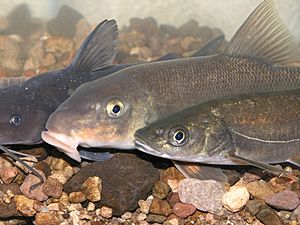Yaqui sucker facts for kids
Quick facts for kids Yaqui sucker |
|
|---|---|
 |
|
| Yaqui sucker in centre | |
| Conservation status | |
| Scientific classification |
The Yaqui sucker (Catostomus bernardini) is a type of fish with fins that look like rays. It belongs to the Catostomidae family. You can find this fish in the Aridoamerica area, which includes northern Mexico and the southwestern United States. The Yaqui sucker is related to the Sonora sucker and might even be a type of Gila sucker.
Contents
About the Yaqui Sucker
The Yaqui sucker has a body shaped like a torpedo, which is a bit long. It has a fairly large head and eyes. Its lips are not as thick as those of other suckers found in Arizona. The fin on its back is tall and has twelve rays. The fins on its belly, back, and tail are bigger in male fish than in female fish.
This fish has scales along its sides, usually between 62 and 73 of them. Its head is darker on top and lighter underneath. The fins on its back and tail are dark, while its other fins are white or yellow. It can be hard to tell the Yaqui sucker apart from its close relative, Catostomus insignis, unless you count the fin rays.
Where Yaqui Suckers Live
You can find the Yaqui sucker in different places in the southwest. These include the Yaqui River in Mexico and the Cajon Bonito area south of Douglas in Cochise County, Arizona. Since 1978, the number of these fish has dropped a lot, and they haven't recovered much.
They have completely disappeared from San Bernardino Creek. The Endangered Species Act is working to protect the fish that are left in Cochise County. Most of them have vanished since 1968.
Yaqui Sucker Habitat
The Yaqui sucker can live in many different places because it can handle various elevations. This fish can live in water systems from the lowest desert streams to the highest mountain brooks. It can be found in all kinds of natural areas, from desert scrub to semi-desert grasslands.
In Arizona, the Yaqui sucker usually lives in muddy pools that are surrounded by plants near the water. But in Mexico, this fish prefers pools and streams with gravel bottoms. The gravel areas of the Yaqui River are better for the Yaqui sucker to lay its eggs.
Yaqui Sucker Life Cycle and Reproduction
Yaqui suckers usually lay their eggs early in the year, especially in March and April. This is because they prefer certain water temperatures. During this time, the male fish turn blue, while the females stay a yellowish-brown color.
Young suckers grow very quickly. They reach 75% of their full size within their first year. This fast growth might be because many other animals hunt them, and because of how they choose their mates. We don't know much else about how these fish reproduce or how they care for their young. This is partly because it's hard to get special permits to study endangered animals.
Suckers like fast, shallow water when there are floods. They move to slower, deeper pools when there are droughts. These fish eat by pulling food from the bottom of streams. This means they need a lot of sediment (like mud and sand) in the water. This is why losing wetlands and other environmental problems are so bad for the sucker. When wetlands disappear and there isn't enough sediment, it strongly leads to the fish vanishing.
Protecting the Yaqui Sucker
Arizona put the Yaqui sucker on the endangered species list in 1988. Not much has been done to help their numbers recover. According to Nature Serve (2002), pumping water from underground, less water flowing in streams, and being eaten by non-native green sunfish are big reasons why the species is declining.
The San Bernardino Ranch plans to put some Yaqui suckers back into the wild to help their population grow. Other projects involve protecting their natural homes. The Dexter National Fish Hatchery has been the most successful. They have found a good way to reintroduce the fish and create the right conditions for them to lay eggs.
Images for kids
See also
 In Spanish: Catostomus bernardini para niños
In Spanish: Catostomus bernardini para niños



